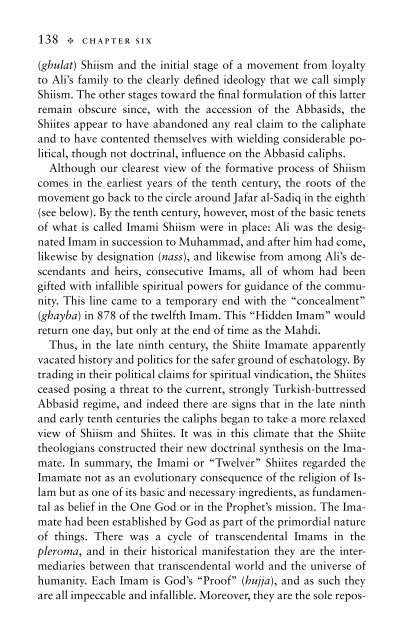Islam: A Guide for Jews and Christians - Electric Scotland
Islam: A Guide for Jews and Christians - Electric Scotland
Islam: A Guide for Jews and Christians - Electric Scotland
You also want an ePaper? Increase the reach of your titles
YUMPU automatically turns print PDFs into web optimized ePapers that Google loves.
138 t CHAPTER SIX<br />
(ghulat) Shiism <strong>and</strong> the initial stage of a movement from loyalty<br />
to Ali’s family to the clearly defined ideology that we call simply<br />
Shiism. The other stages toward the final <strong>for</strong>mulation of this latter<br />
remain obscure since, with the accession of the Abbasids, the<br />
Shiites appear to have ab<strong>and</strong>oned any real claim to the caliphate<br />
<strong>and</strong> to have contented themselves with wielding considerable political,<br />
though not doctrinal, influence on the Abbasid caliphs.<br />
Although our clearest view of the <strong>for</strong>mative process of Shiism<br />
comes in the earliest years of the tenth century, the roots of the<br />
movement go back to the circle around Jafar al-Sadiq in the eighth<br />
(see below). By the tenth century, however, most of the basic tenets<br />
of what is called Imami Shiism were in place: Ali was the designated<br />
Imam in succession to Muhammad, <strong>and</strong> after him had come,<br />
likewise by designation (nass), <strong>and</strong> likewise from among Ali’s descendants<br />
<strong>and</strong> heirs, consecutive Imams, all of whom had been<br />
gifted with infallible spiritual powers <strong>for</strong> guidance of the community.<br />
This line came to a temporary end with the “concealment”<br />
(ghayba) in 878 of the twelfth Imam. This “Hidden Imam” would<br />
return one day, but only at the end of time as the Mahdi.<br />
Thus, in the late ninth century, the Shiite Imamate apparently<br />
vacated history <strong>and</strong> politics <strong>for</strong> the safer ground of eschatology. By<br />
trading in their political claims <strong>for</strong> spiritual vindication, the Shiites<br />
ceased posing a threat to the current, strongly Turkish-buttressed<br />
Abbasid regime, <strong>and</strong> indeed there are signs that in the late ninth<br />
<strong>and</strong> early tenth centuries the caliphs began to take a more relaxed<br />
view of Shiism <strong>and</strong> Shiites. It was in this climate that the Shiite<br />
theologians constructed their new doctrinal synthesis on the Imamate.<br />
In summary, the Imami or “Twelver” Shiites regarded the<br />
Imamate not as an evolutionary consequence of the religion of <strong>Islam</strong><br />
but as one of its basic <strong>and</strong> necessary ingredients, as fundamental<br />
as belief in the One God or in the Prophet’s mission. The Imamate<br />
had been established by God as part of the primordial nature<br />
of things. There was a cycle of transcendental Imams in the<br />
pleroma, <strong>and</strong> in their historical manifestation they are the intermediaries<br />
between that transcendental world <strong>and</strong> the universe of<br />
humanity. Each Imam is God’s “Proof” (hujja), <strong>and</strong> as such they<br />
are all impeccable <strong>and</strong> infallible. Moreover, they are the sole repos-
















